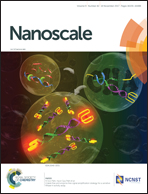EGFR-targeting PLGA-PEG nanoparticles as a curcumin delivery system for breast cancer therapy
Abstract
Poor bioavailability and non-specificity of chemotherapeutic agents are major challenges in breast cancer treatment. Antibodies and small molecules that block cell signaling pathways have shown promise in the clinic, but their application is also limited by the high costs and treatment dosages required. Novel therapies that aim to rapidly and specifically target malignant cells with long-lasting impact in the tumor microenvironment may ultimately improve clinical outcome in cancer patients. Here, we demonstrate that epidermal growth factor receptor (EGFR)-targeting GE11 peptides conjugated with PEGylated polylactic-co-glycolic acid (PLGA) nanoparticles can be used to effectively deliver an anti-cancer agent, curcumin, into EGFR-expressing MCF-7 cells in vitro and in vivo. Treatment of breast cancer cells and tumor-bearing mice with these curcumin-loaded nanoparticles gave rise to reduced phosphoinositide 3-kinase signaling, decreased cancer cell viability, attenuated drug clearance from the circulation, and suppressed tumor burden compared with free curcumin or non-EGFR targeting nanoparticles. The targeted nanoscale drug delivery system we describe here may provide a new strategy for the design of targeted cancer therapy vectors. Our study provides evidence that the efficacy of pharmacologic anti-cancer agents can be enhanced through their delivery in the form of modified nanoparticles that effectively target specific malignant cell types.



 Please wait while we load your content...
Please wait while we load your content...